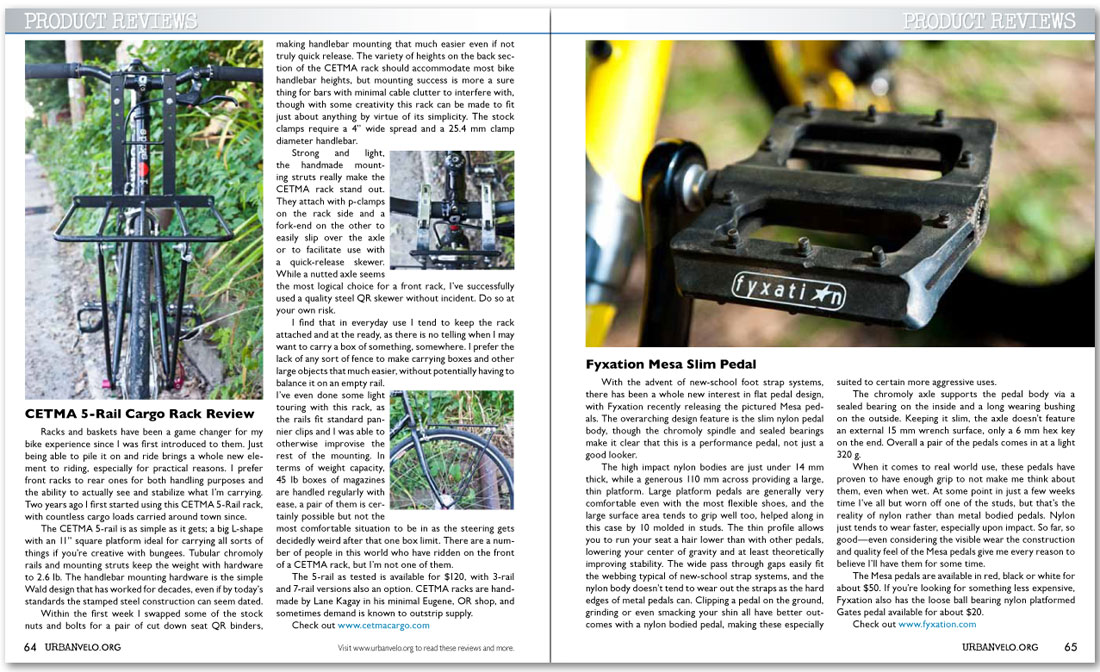


CETMA 5-Rail Cargo Rack Review
Racks and baskets have been a game changer for my bike experience since I was first introduced to them. Just being able to pile it on and ride brings a whole new element to riding, especially for practical reasons. I prefer front racks to rear ones for both handling purposes and the ability to actually see and stabilize what I’m carrying. Two years ago I first started using this CETMA 5-Rail rack, with countless cargo loads carried around town since.
The CETMA 5-rail is as simple as it gets; a big L-shape with an 11” square platform ideal for carrying all sorts of things if you’re creative with bungees. Tubular chromoly rails and mounting struts keep the weight with hardware to 2.6 lb. The handlebar mounting hardware is the simple Wald design that has worked for decades, even if by today’s standards the stamped steel construction can seem dated.
Within the first week I swapped some of the stock nuts and bolts for a pair of cut down seat QR binders, making handlebar mounting that much easier even if not truly quick release. The variety of heights on the back section of the CETMA rack should accommodate most bike handlebar heights, but mounting success is more a sure thing for bars with minimal cable clutter to interfere with, though with some creativity this rack can be made to fit just about anything by virtue of its simplicity. The stock clamps require a 4” wide spread and a 25.4 mm clamp diameter handlebar.
Strong and light, the handmade mounting struts really make the CETMA rack stand out. They attach with p-clamps on the rack side and a fork-end on the other to easily slip over the axle or to facilitate use with a quick-release skewer. While a nutted axle seems the most logical choice for a front rack, I’ve successfully used a quality steel QR skewer without incident. Do so at your own risk.
I find that in everyday use I tend to keep the rack attached and at the ready, as there is no telling when I may want to carry a box of something, somewhere. I prefer the lack of any sort of fence to make carrying boxes and other large objects that much easier, without potentially having to balance it on an empty rail. I’ve even done some light touring with this rack, as the rails fit standard pannier clips and I was able to otherwise improvise the rest of the mounting. In terms of weight capacity, 45 lb boxes of magazines are handled regularly with ease, a pair of them is certainly possible but not the most comfortable situation to be in as the steering gets decidedly weird after that one box limit. There are a number of people in this world who have ridden on the front of a CETMA rack, but I’m not one of them.
The 5-rail as tested is available for $120, with 3-rail and 7-rail versions also an option. CETMA racks are handmade by Lane Kagay in his minimal Eugene, OR shop, and sometimes demand is known to outstrip supply.
Check out www.cetmacargo.com
Fyxation Mesa Slim Pedal
With the advent of new-school foot strap systems, there has been a whole new interest in flat pedal design, with Fyxation recently releasing the pictured Mesa pedals. The overarching design feature is the slim nylon pedal body, though the chromoly spindle and sealed bearings make it clear that this is a performance pedal, not just a good looker.
The high impact nylon bodies are just under 14 mm thick, while a generous 110 mm across providing a large, thin platform. Large platform pedals are generally very comfortable even with the most flexible shoes, and the large surface area tends to grip well too, helped along in this case by 10 molded in studs. The thin profile allows you to run your seat a hair lower than with other pedals, lowering your center of gravity and at least theoretically improving stability. The wide pass through gaps easily fit the webbing typical of new-school strap systems, and the nylon body doesn’t tend to wear out the straps as the hard edges of metal pedals can. Clipping a pedal on the ground, grinding or even smacking your shin all have better outcomes with a nylon bodied pedal, making these especially suited to certain more aggressive uses.
The chromoly axle supports the pedal body via a sealed bearing on the inside and a long wearing bushing on the outside. Keeping it slim, the axle doesn’t feature an external 15 mm wrench surface, only a 6 mm hex key on the end. Overall a pair of the pedals comes in at a light 320 g.
When it comes to real world use, these pedals have proven to have enough grip to not make me think about them, even when wet. At some point in just a few weeks time I’ve all but worn off one of the studs, but that’s the reality of nylon rather than metal bodied pedals. Nylon just tends to wear faster, especially upon impact. So far, so good—even considering the visible wear the construction and quality feel of the Mesa pedals give me every reason to believe I’ll have them for some time.
The Mesa pedals are available in red, black or white for about $50. If you’re looking for something less expensive, Fyxation also has the loose ball bearing nylon platformed Gates pedal available for about $20.
Check out www.fyxation.com